Create DNS records at Amazon Web Services (AWS) for Office 365
Check the Domains FAQ if you don't find what you're looking for.
If AWS is your DNS hosting provider, follow the steps in this article to verify your domain and set up DNS records for email, Lync, and so on.
These are the main records to add.
After you add these records at AWS, your domain will be set up to work with Office 365 services.
To learn about webhosting and DNS for websites with Office 365, see Use a public website with Office 365.
Note: Typically it takes about 15 minutes for DNS changes to take effect. However, it can occasionally take longer for a change you've made to update across the Internet's DNS system. If you're having trouble with mail flow or other issues after adding DNS records, see Troubleshoot issues after changing your domain name or DNS records.
Add a TXT record for verification
Before you use your domain with Office 365, we have to make sure that you own it. Your ability to log in to your account at your domain registrar and create the DNS record proves to Office 365 that you own the domain.
Note: This record is used only to verify that you own your domain; it doesn't affect anything else. You can delete it later, if you like.
-
To get started, go to your domains page at AWS by using this link. You'll be prompted to log in first.
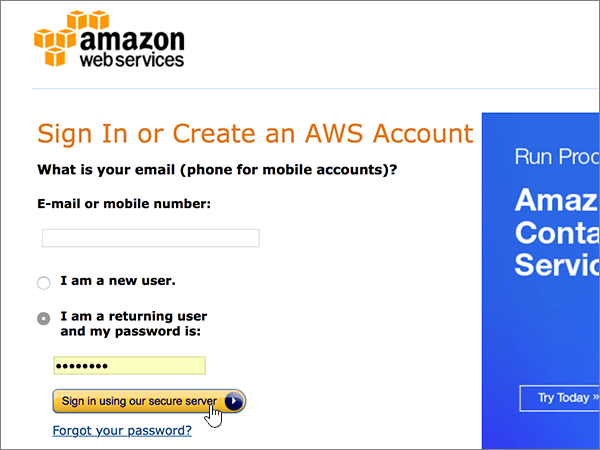
-
On the Resources page, choose Hosted Zones.
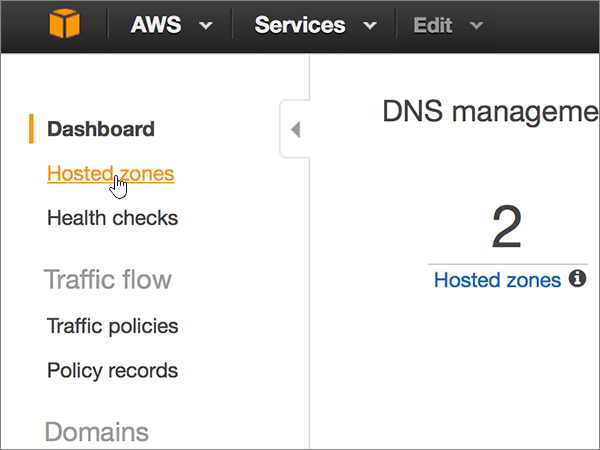
-
On the Hosted Zones page, in the Domain Name column, choose the name of the domain that you want to edit.
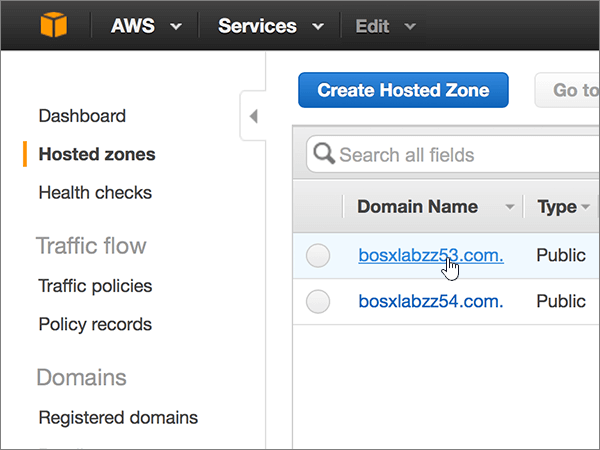
-
Choose Create Record Set.
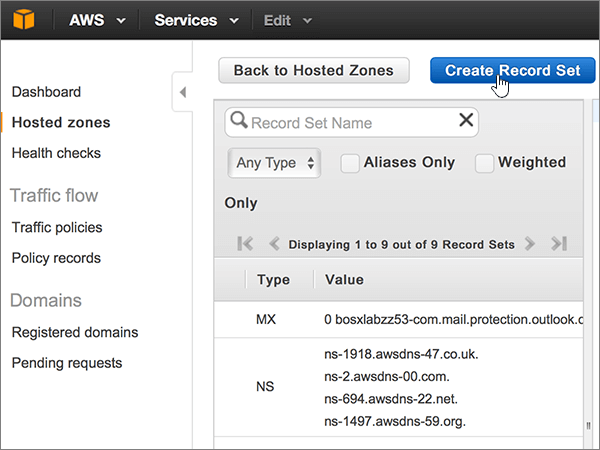
-
In the Create Record Set area, in the boxes for the new record, type or copy and paste the values from the following table.
(Choose the Type and Routing Policy values from the drop-down lists.)
Tip: The quotation marks required by the onscreen instructions are supplied automatically. You don't need to type them manually.
Name
Type
Alias
TTL (Seconds)
Value
Routing Policy
(Leave this field empty.)
TXT - Text
No
300
MS=msXXXXXXXX
Note: This is an example. Use your specific Destination or Points to Address value here, from the table in Office 365.
How do I find this?Simple
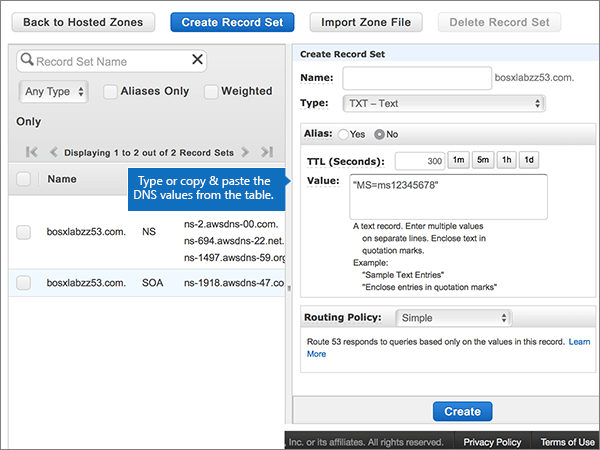
-
Choose Create.
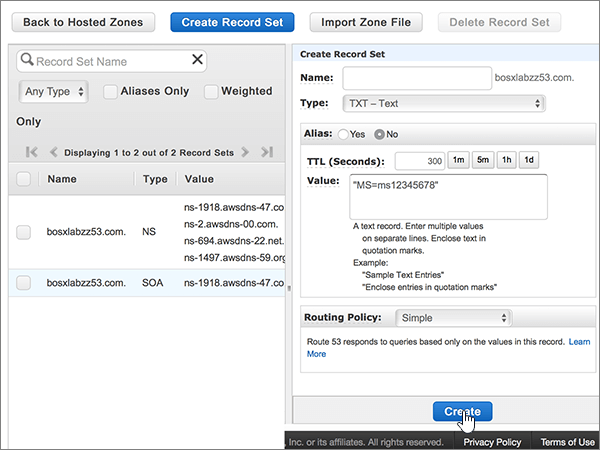
-
Wait a few minutes before you continue, so that the record you just created can update across the Internet.
Now that you've added the record at your domain registrar's site, you'll go back to Office 365 and request Office 365 to look for the record.
When Office 365 finds the correct TXT record, your domain is verified.
-
Choose Setup > Domains.
-
On the Domains page, choose the domain that you are verifying.
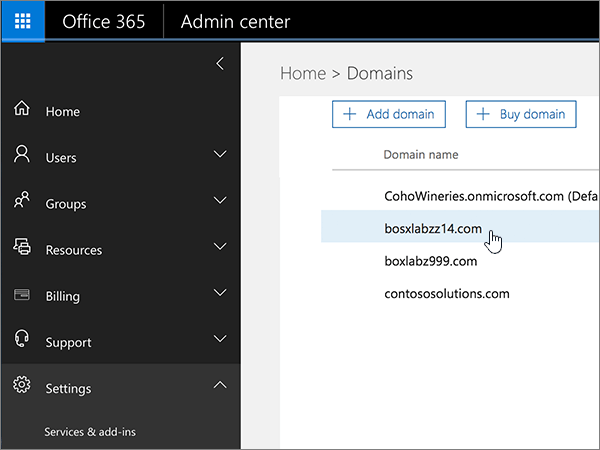
-
On the Setup page, choose Start setup.
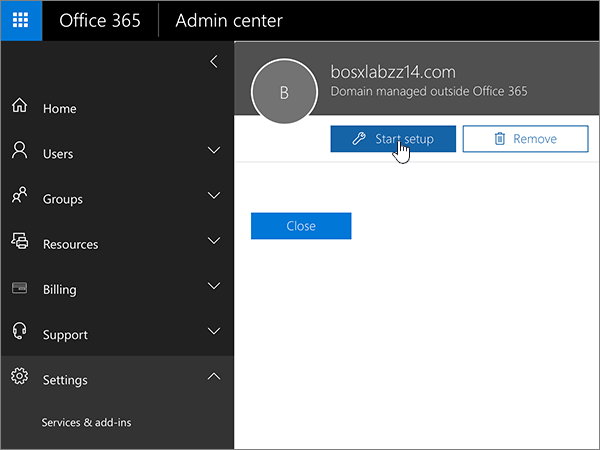
-
On the Verify domain page, choose Verify.
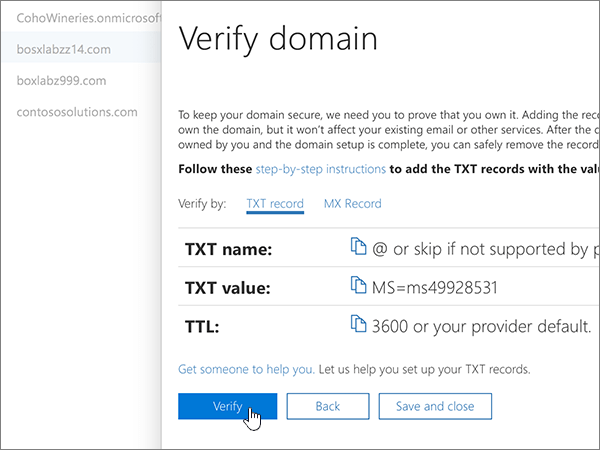
Note: Typically it takes about 15 minutes for DNS changes to take effect. However, it can occasionally take longer for a change you've made to update across the Internet's DNS system. If you're having trouble with mail flow or other issues after adding DNS records, see Troubleshoot issues after changing your domain name or DNS records.
Add an MX record so email for your domain will come to Office 365
-
To get started, go to your domains page at AWS by using this link. You'll be prompted to log in first.

-
On the Resources page, choose Hosted Zones.

-
On the Hosted Zones page, in the Domain Name column, choose the name of the domain that you want to edit.

-
Choose Create Record Set.

-
In the Create Record Set area, in the boxes for the new record, type or copy and paste the values from the following table.
(Choose the Type and Routing Policy values from the drop-down lists.)
Name
Type
Alias
TTL (Seconds)
Value
Routing Policy
(Leave this field empty.)
MX - Mail exchange
No
300
0 <domain-key>.mail.protection.outlook.com.
The 0 is the MX priority value. Add it to the beginning of the MX value, separated from the remainder of the value by a space.
This value MUST end with a period (.)
Note: Get your <domain-key> from your Office 365 portal account.
How do I find this?Simple
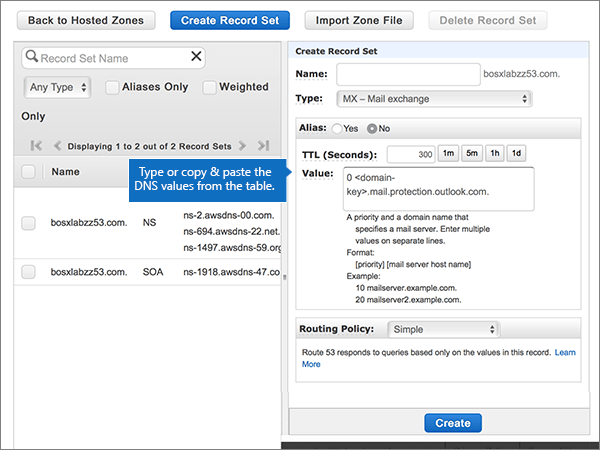
-
Choose Create.
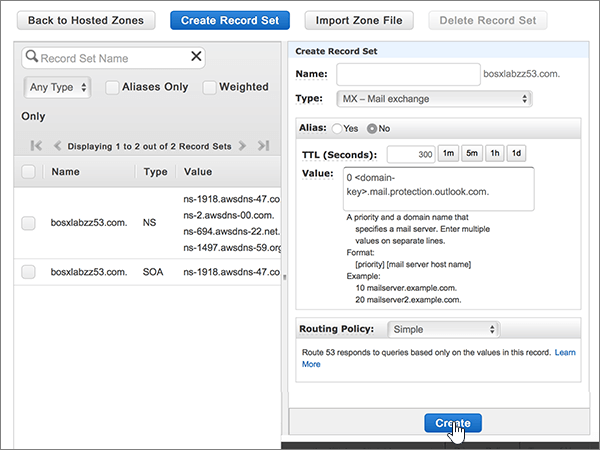
-
If there are any other MX records, remove them.
Important: AWS stores MX records as a set that may contain multiple records. DO NOT choose Delete Record Set, as this will delete all of your MX records, including the one you just added. Use the following instructions instead.
First, choose the MX record set.
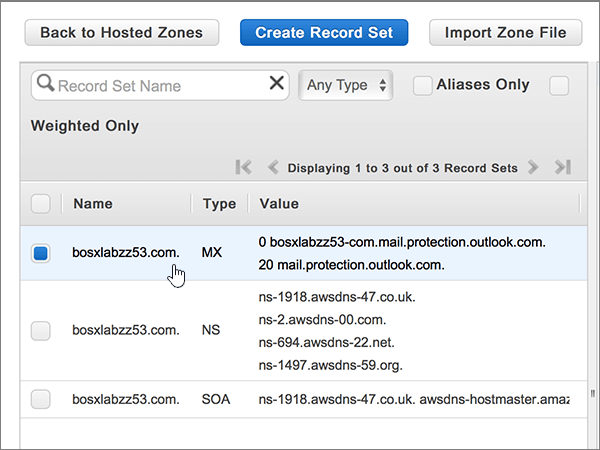
Next, in the Edit Record Set area, delete each obsolete MX record by selecting the entry in the Value box and then pressing the Delete key on your keyboard.
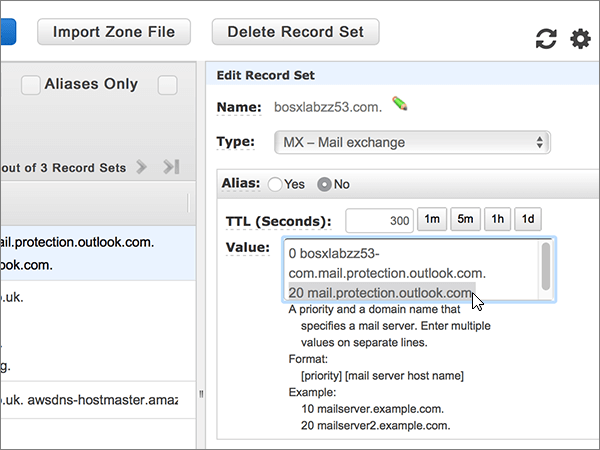
-
Choose Save Record Set.
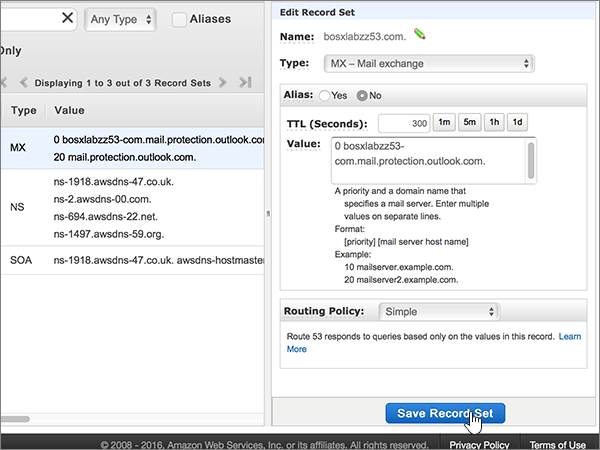
Add the six CNAME records that are required for Office 365
-
To get started, go to your domains page at AWS by using this link. You'll be prompted to log in first.

-
On the Resources page, choose Hosted Zones.

-
On the Hosted Zones page, in the Domain Name column, choose the name of the domain that you want to edit.

-
Choose Create Record Set.

-
Add the first CNAME record.
In the Create Record Set area, in the boxes for the new record, type or copy and paste the values from the first row in the following table.
(Choose the Type and Routing Policy values from the drop-down lists.)
Name
Type
Alias
TTL (Seconds)
Value
Routing Policy
autodiscover
CNAME - Canonical name
No
300
autodiscover.outlook.com.
This value MUST end with a period (.)
Simple
sip
CNAME - Canonical name
No
300
sipdir.online.lync.com.
This value MUST end with a period (.)
Simple
lyncdiscover
CNAME - Canonical name
No
300
webdir.online.lync.com.
This value MUST end with a period (.)
Simple
msoid
CNAME - Canonical name
No
300
clientconfig.microsoftonline-p.net.
This value MUST end with a period (.)
Simple
enterpriseregistration
CNAME - Canonical name
No
300
enterpriseregistration.windows.net.
This value MUST end with a period (.)
Simple
enterpriseenrollment
CNAME - Canonical name
No
300
enterpriseenrollment.manage.microsoft.com.
This value MUST end with a period (.)
Simple
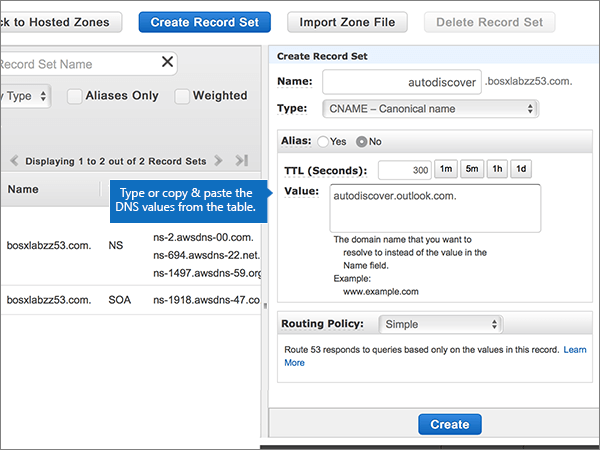
-
Choose Create.
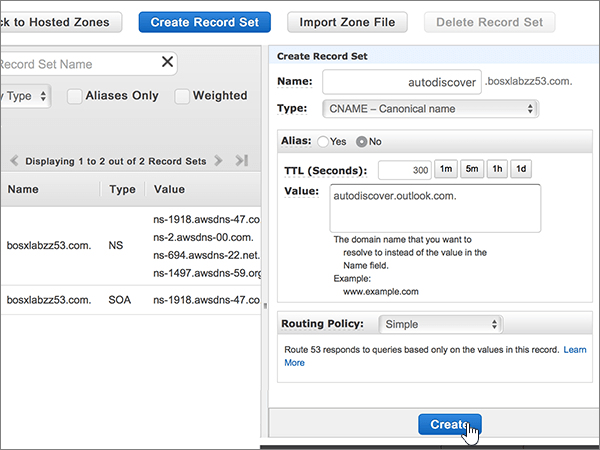
-
Add the other five CNAME records.
In the Hosted Zones page, choose Create Record Set, create a record using the values from the next row in the table, and then again choose Create to complete that record.
Repeat this process until you have created all six CNAME records.
Add a TXT record for SPF to help prevent email spam
Important: You cannot have more than one TXT record for SPF for a domain. If your domain has more than one SPF record, you'll get email errors, as well as delivery and spam classification issues. If you already have an SPF record for your domain, don't create a new one for Office 365. Instead, add the required Office 365 values to the current record so that you have a single SPF record that includes both sets of values. Need examples? Check out these details and sample SPF records. To validate your SPF record, you can use one of these SPF validation tools.
-
To get started, go to your domains page at AWS by using this link. You'll be prompted to log in first.

-
On the Resources page, choose Hosted Zones.

-
On the Hosted Zones page, in the Domain Name column, choose the name of the domain that you want to edit.

-
Choose the TXT record set.
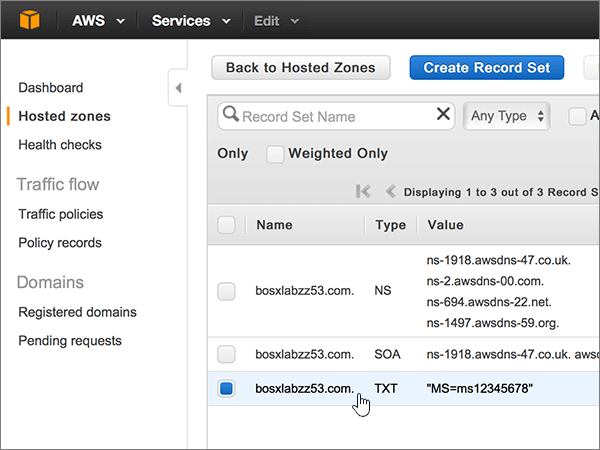
-
In the Edit Record Set area, at the end of the current entry in the Value: box for the existing record, press Enter on your keyboard to create a new line; and then, on that new line (under the existing value), type or copy and paste the value from the following table. (You can see an example in the illustration below the table.)
Value:
v=spf1 include:spf.protection.outlook.com –all
(The quotation marks required by the onscreen instructions are supplied automatically. You don't need to type them manually.)
Note: We recommend copying and pasting this entry, so that all of the spacing stays correct.
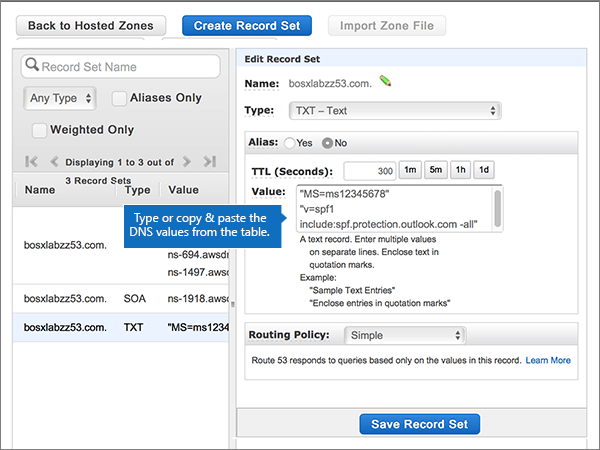
-
Choose Save Record Set.
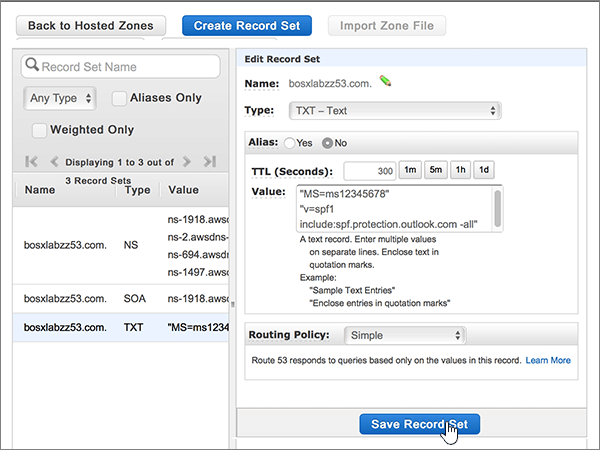
Add the two SRV records that are required for Office 365
-
To get started, go to your domains page at AWS by using this link. You'll be prompted to log in first.

-
On the Resources page, choose Hosted Zones.

-
On the Hosted Zones page, in the Domain Name column, choose the name of the domain that you want to edit.

-
Choose Create Record Set.

-
Add the first SRV record:
In the Create Record Set area, in the boxes for the new record, type or copy and paste the values from the first row in the following table.
(Choose the Type and Routing Policy values from the drop-down lists.)
Name
Type
Alias
TTL (Seconds)
Value
Routing Policy
_sip._tls
SRV - Service locator
No
300
100 1 443 sipdir.online.lync.com.
This value MUST end with a period (.)
Note: We recommend copying and pasting this entry, so that all of the spacing stays correct.
Simple
_sipfederationtls._tcp
SRV - Service locator
No
300
100 1 5061 sipfed.online.lync.com.
This value MUST end with a period (.)
Note: We recommend copying and pasting this entry, so that all of the spacing stays correct.
Simple
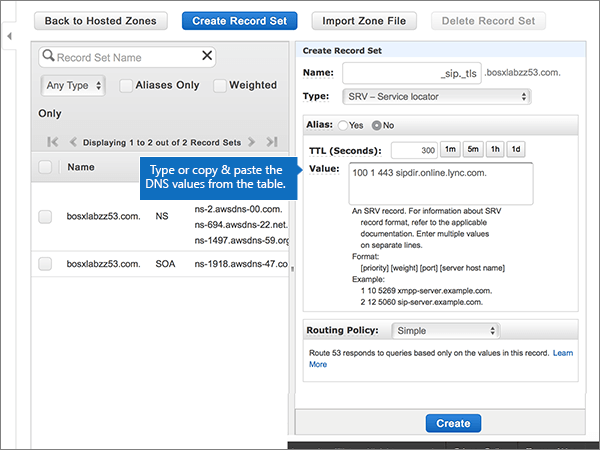
-
Choose Create.
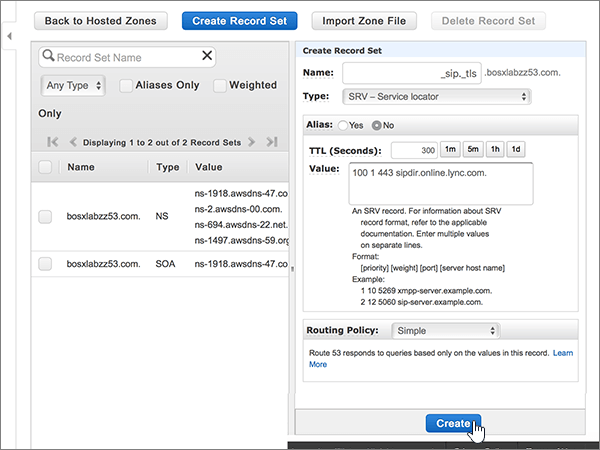
-
To add the other SRV record:
In the Hosted Zones page, choose Create Record Set, create a record using the values from the next row in the table, and then again choose Create to complete that record.
Note: Typically it takes about 15 minutes for DNS changes to take effect. However, it can occasionally take longer for a change you've made to update across the Internet's DNS system. If you're having trouble with mail flow or other issues after adding DNS records, see Troubleshoot issues after changing your domain name or DNS records.
Still need help?




This is a very nice one and gives in-depth information. I am really happy with the quality and presentation of the article. I’d really like to appreciate the efforts you get with writing this post. Thanks for sharing.
ReplyDeleteAWS training in Noida
salesforce training
ReplyDeletehadoop training
Data Science training
linux training
Thank you for saving my job today!
ReplyDeleteHello, an amazing Information dude. Thanks for sharing this nice information with us.
ReplyDeleteWe are the most fantastic Amazon service agency, and we aim high with your Amazon advertising because it is such an essential part of your business.
Pretty! This was a really wonderful article. Thank you for supplying this info. In Meanwhile please have look create amazon account without phone number
ReplyDeletehybris development outsourcing
ReplyDeleteFor businesses seeking exceptional recruitment services, Recutify.inc is your ideal partner. We specialize in connecting employers with top talent, ensuring a streamlined and efficient hiring process to meet your staffing needs nationwide. Explore more here.
ReplyDelete